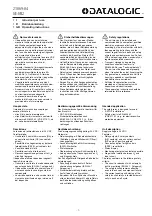
Functions
2.21 Fault Locator
SIPROTEC, 7SD5, Manual
C53000-G1176-C169-5, Release date 02.2011
388
The evaluation of the measured values in the short-circuit loops is carried out after the short-circuit has been
cleared. Short-circuit loops are those which caused the trip. In the event of tripping by the earth fault protection,
the three phase–to-earth loops are also evaluated.
Double-Ended Fault Locator
The double-ended fault locating method also considers line capacitance and line resistance. It adapts the fault
location for an optimum matching between the voltages calculated for the fault location and the values mea-
sured at the line ends. It is assumed in this context that voltages on a line cannot leap. The voltage at the pre-
sumed fault location is calculated once with the values measured from the left side and once with those from
the right side. The actual fault location is where there is no or hardly any difference between the voltage char-
acteristics from the left and the right side.
The double-ended fault locator method is based on the assumption that in a line without branches, with known
currents and voltages at the inputs, the voltage can be calculated for any location x of the line. This applies for
both - the left and the right side of the line. Since the voltage at the fault location calculated from both sides
must be the same, the fault is located at the intersection of the two voltage characteristics. These characteris-
tics are calculated by means of the telegraph equation from the locally measured currents and voltages, and
the reactances per line unit. Figure 2-180 shows a simplified schematic in which linear voltage characteristics
are assumed.
Figure 2-180
Curves of voltages on a faulty line (simplified)
The double-ended fault locating method used here has the following advantages over the single-ended
method:
• Correct fault locating is possible even with power flowing on the line, with double-sided infeed and high fault
resistances.
• The precision of fault locating is not affected by an inaccurate setting of the earth impedance compensation.
• The method is stable against the influence of a parallel line, so parallel line compensation is not required.
• The accuracy can be increased if the line asymmetry (selection of the central conductor) is taken into ac-
count.
















































